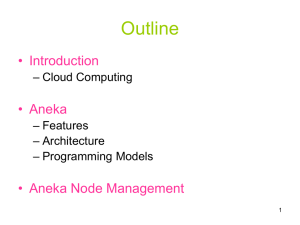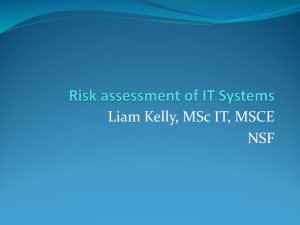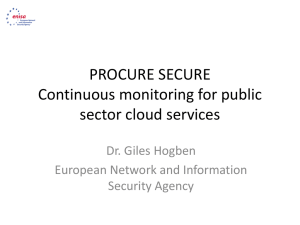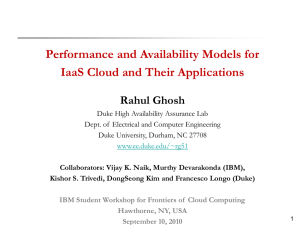Sla-Oriented Resource provisioning for cloud computing
advertisement
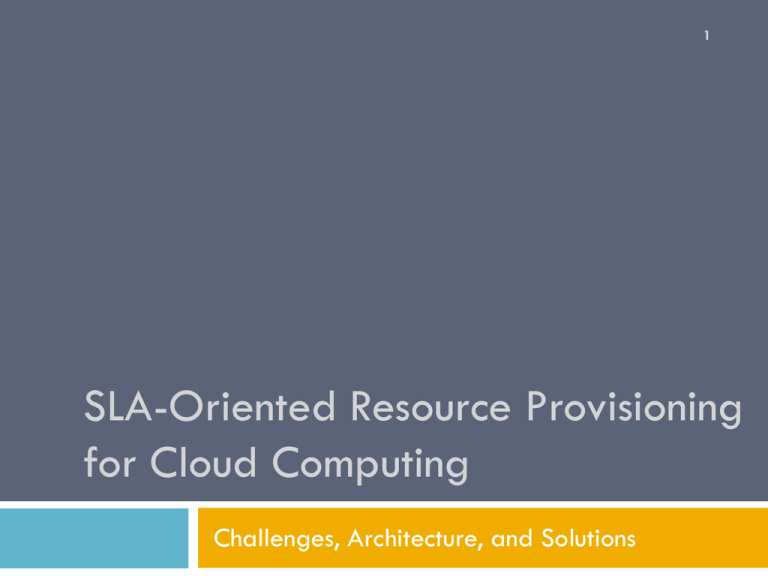
1 SLA-Oriented Resource Provisioning for Cloud Computing Challenges, Architecture, and Solutions Author 2 Content 3 Abstract Introduction Challenges and Requirements SLA-Oriented Cloud Computing Vision State-of-the-art System Architecture SLA Provisioning in Aneka Performance Evaluation Future Directions Abstract 4 Need to offer differentiated services to users and meet their quality expectations. Existing resource management systems are yet to support SLA-oriented resource allocation. No work has been done to collectively incorporate customer-driven service management, computational risk management, and autonomic resource management into a market-based resource management system to target the rapidly changing enterprise requirements of Cloud computing. This paper presents vision, challenges, and architectural elements of SLA-oriented resource management. Introduction 5 There are dramatic differences between developing software for millions to use as a service versus distributing software for millions to run their PCs -- Professor David Patterson New Computing Paradigms Cloud Computing Grid Computing P2P Computing Utility Computing Challenges and Requirements - 1 6 Challenges and Requirements - 2 7 Customer-driven Service Management Computational Risk Management Autonomic Resource Management SLA-oriented Resource Allocation Through Virtualization Service Benchmarking and Measurement System Modeling and Repeatable Evaluation SLA-Oriented Cloud Computing Vision 8 The resource provisioning will be driven by market-oriented principles for efficient resource allocation depending on user QoS targets and workload demand patterns. Support for customer-driven service management based on customer profiles and QoS requirements; Definition of computational risk management tactics to identify, assess, and manage risks involved in the execution of applications; Derivation of appropriate market-based resource management strategies that encompass both customer-driven service management and computational risk management to sustain SLA-oriented resource allocation; Incorporation of autonomic resource management models; Leverage of Virtual Machine technology to dynamically assign resource shares; Implementation of the developed resource management strategies and models into a real computing server; State-of-the-art 9 Traditional Resource Management Systems(Condor, LoadLeveler, Load Sharing Facility, Portable Batch System) adopt system-centric resource allocation approaches that focus on optimizing overall cluster performance Assume that all job requests are of equal user importance and neglect actual levels of service required by different users. Virtual Machine management platform solutions(Eucalyptus, OpenStack, Apache VCL, Citrix Essentials) Increase processor throughput and utilization for the cluster Reduce the average waiting time and response time for jobs Main goal is to provide automatic configuration and maintenance of the centers Market-based resource management Not considered and incorporated customer-driven service management, System Architecture 10 High-level system architectural framework SLA Provisioning in Aneka -1 11 Aneka architecture SLA Provisioning in Aneka - 2 12 SLA Provisioning in Aneka - 3 13 SLA Provisioning in Aneka - 4 14 Performance Evaluation - 1 15 Static resource 1 Aneka master - m1.large(7.5GB memory, 4 EC2 compute units, 850GB instance storage, 64bit platform, US0.48 per instance per hour) Windows-based VM 4 Aneka workers – m1.small(1.7GB memory, 1 EC2 compute unit, 160GB instance storage, 32bit platform, US0.085 per instance per hour) Linux-based VM Dynamic resources m1.small Linux-based instances Performance Evaluation - 2 16 CPU-intensive application SLA is defined in terms of user-defined deadline execution time of each task was set to 2 minutes Each job consists of 120 tasks Conclusions and Future Directions 17 The need for a deeper investigation in SLAoriented resource allocation strategies that encompass: Customer-driven service management Computational risk management Autonomic management of Clouds In order to: Improve the system efficiency Minimize violation of SLAs Improve profitability of service providers 18 Thanks !
